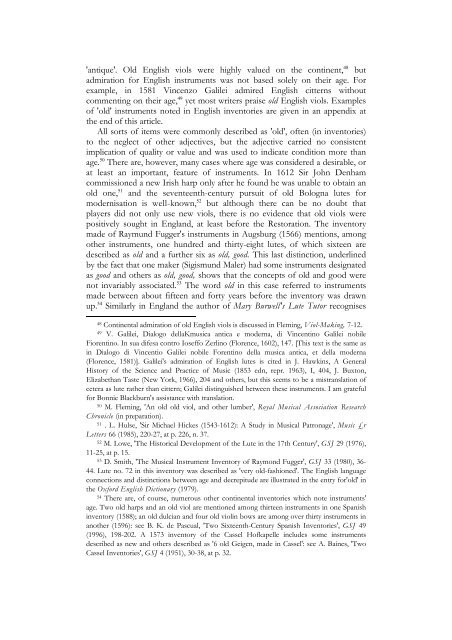download.pdf - 1.2Mb - Viola da Gamba Society
download.pdf - 1.2Mb - Viola da Gamba Society
download.pdf - 1.2Mb - Viola da Gamba Society
Create successful ePaper yourself
Turn your PDF publications into a flip-book with our unique Google optimized e-Paper software.
'antique'. Old English viols were highly valued on the continent, 48 but<br />
admiration for English instruments was not based solely on their age. For<br />
example, in 1581 Vincenzo Galilei admired English citterns without<br />
commenting on their age, 49 yet most writers praise old English viols. Examples<br />
of 'old' instruments noted in English inventories are given in an appendix at<br />
the end of this article.<br />
All sorts of items were commonly described as 'old', often (in inventories)<br />
to the neglect of other adjectives, but the adjective carried no consistent<br />
implication of quality or value and was used to indicate condition more than<br />
age. 50 There are, however, many cases where age was considered a desirable, or<br />
at least an important, feature of instruments. In 1612 Sir John Denham<br />
commissioned a new Irish harp only after he found he was unable to obtain an<br />
old one, 51 and the seventeenth-century pursuit of old Bologna lutes for<br />
modernisation is well-known, 52 but although there can be no doubt that<br />
players did not only use new viols, there is no evidence that old viols were<br />
positively sought in England, at least before the Restoration. The inventory<br />
made of Raymund Fugger's instruments in Augsburg (1566) mentions, among<br />
other instruments, one hundred and thirty-eight lutes, of which sixteen are<br />
described as old and a further six as old, good. This last distinction, underlined<br />
by the fact that one maker (Sigismund Maler) had some instruments designated<br />
as good and others as old, good, shows that the concepts of old and good were<br />
not invariably associated. 53 The word old in this case referred to instruments<br />
made between about fifteen and forty years before the inventory was drawn<br />
up. 54 Similarly in England the author of Mary Burwell's Lute Tutor recognises<br />
48 Continental admiration of old English viols is discussed in Fleming, Viol-Making, 7-12.<br />
49 V. Galilei, Dialogo dellaKmusica antica e moderna, di Vincentino Galilei nobile<br />
Fiorentino. In sua difesa contro Ioseffo Zerlino (Florence, 1602), 147. [This text is the same as<br />
in Dialogo di Vincentio Galilei nobile Forentino della musica antica, et della moderna<br />
(Florence, 1581)]. Galilei's admiration of English lutes is cited in J. Hawkins, A General<br />
History of the Science and Practice of Music (1853 edn, repr. 1963), I, 404, J. Buxton,<br />
Elizabethan Taste (New York, 1966), 204 and others, but this seems to be a mistranslation of<br />
cetera as lute rather than cittern; Galilei distinguished between these instruments. I am grateful<br />
for Bonnie Blackburn's assistance with translation.<br />
50 M. Fleming, 'An old old viol, and other lumber', Royal Musical Association Research<br />
Chronicle (in preparation).<br />
51 . L. Hulse, 'Sir Michael Hickes (1543-1612): A Study in Musical Patronage', Music £r<br />
Letters 66 (1985), 220-27, at p. 226, n. 37.<br />
52 M. Lowe, 'The Historical Development of the Lute in the 17th Century', GSJ 29 (1976),<br />
11-25, at p. 15.<br />
53 D. Smith, 'The Musical Instrument Inventory of Raymond Fugger', GSJ 33 (1980), 36-<br />
44. Lute no. 72 in this inventory was described as 'very old-fashioned'. The English language<br />
connections and distinctions between age and decrepitude are illustrated in the entry for'old' in<br />
the Oxford English Dictionary (1979).<br />
54 There are, of course, numerous other continental inventories which note instruments'<br />
age. Two old harps and an old viol are mentioned among thirteen instruments in one Spanish<br />
inventory (1588); an old dulcian and four old violin bows are among over thirty instruments in<br />
another (1596): see B. K. de Pascual, 'Two Sixteenth-Century Spanish Inventories', GSJ 49<br />
(1996), 198-202. A 1573 inventory of the Cassel Hofkapelle includes some instruments<br />
described as new and others described as '6 old Geigen, made in Cassel': see A. Baines, 'Two<br />
Cassel Inventories', GSJ 4 (1951), 30-38, at p. 32.
















